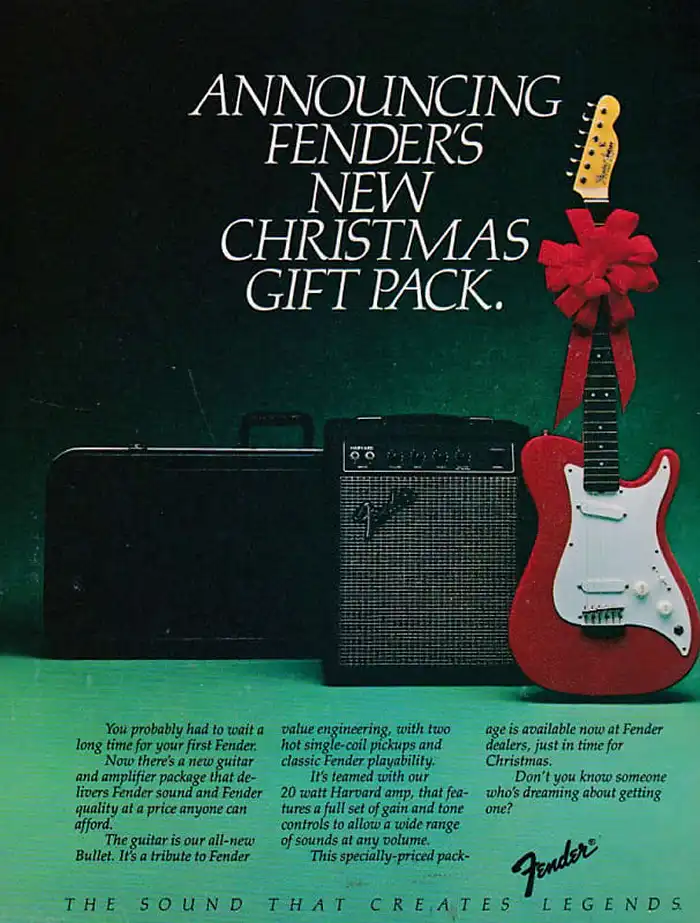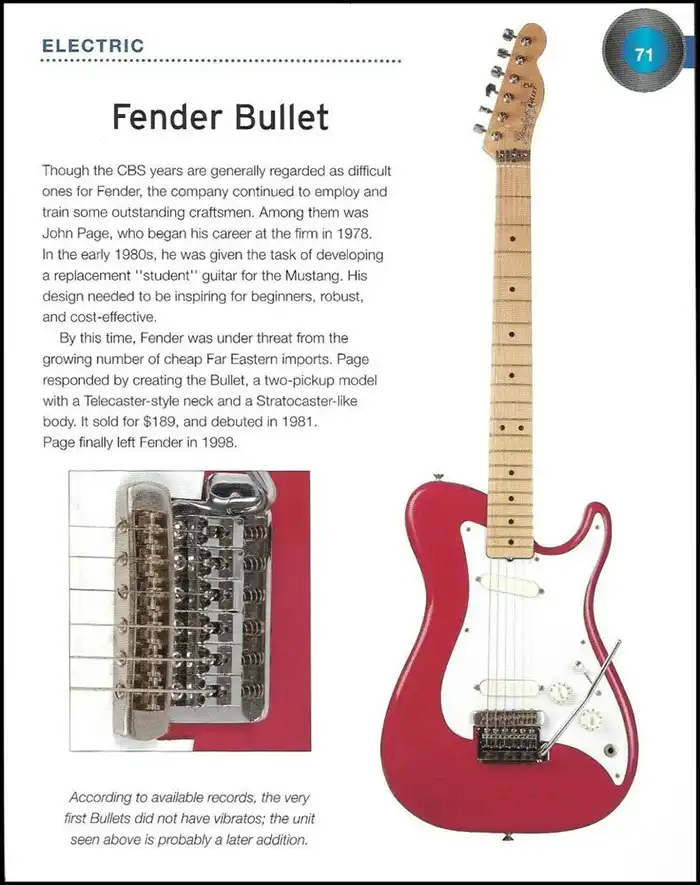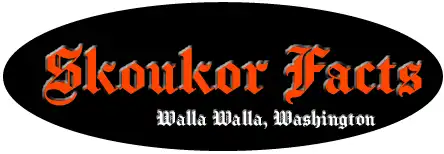The History of the Fender Bullet - Made in USA
By Dennis David
Fender Musical Instruments, to compete with the oversea markets, planned on producing the Bullet 1 Guitars outside the United
States to lower production cost, but the foreign made parts were below John Page's standards, and production was moved back to
the United States; causing the early 1981 to 1983 Bullet 1 Guitars to be made and assembled with Fender USA craftsmanship in
Fullerton, California.
The Fender Bullet 1 was John Page's first Fender Guitar design in 1981, and the Bullet's unique one-piece alloy bridge-pickguard
combination was John's first US patent; the bridge-pickguard cut cost by combining the bridge, pickguard, and providing
electronic shielding in a single component. Because the original Bullet 1 was made for a limited period, many of the parts are
hard to find.
The History of the Fender Bullet 1 spans over 35 years, beginning in the early 80's when Fender Musical Instruments was looking
to produce inexpensive guitars, to counter the cheap, foreign, starter guitars. The Original Fender Bullet 1's were hybrids of
the Fender Telecaster, Stratocaster, and the Mustang guitars; John Page cut cost by capitalizing on readymade, unused Fender
Guitar parts, the guitar was designed to reduce manufacturing cost.
All Bullet Headstock decals show the words Fender Bullet and have a silver star with the number 1 inside the star. The serial
numbers located on the headstock, typically begin with E0 or E1, (E designating the 1980's) but sometimes the serial number
doesn't start with a letter prefix. Some decals contain the words Made in U.S.A., and other decals do not contain the words.

In the Early 80's, the thin C-Profile, maple necks on the first Bullets were Fender Telecaster necks, and in 1981 were only
offered with a rosewood fretboard; and in 1982, and onwards, offered either in rosewood or solid maple fretboards.
The 1981 Bullets had Kluson tuners, which were changed in 1982 to the 1970's style Fender F tuners when Kluson Manufacturing went
out of business in '81, and finally replaced in 1983 by sealed Fender tuners, once the supply of F-style tuners ran out. This was
a transitional time at Fender Instruments, cost was being scrutinized, and waste circumvented when possible.
The 1981 Fender Bullet 1 bodies were smaller, highly contoured, Telecaster bodies, which were produced for one year, but utilized
in guitar production for both 1981 and 1982. And in 1982 a smaller, highly contoured Stratocaster Bullet 1 body replaced the
Telecaster Bullet 1 body in production. The first Bullet 1 bodies were limited to a cream (ivory) or red color. In 1982 sunburst
and walnut were added to the color line up on the new Bullet Strats.
The First Bullet 1 Pickups were single coil, Fender Mustang Pickups with the pickup positioning the same as the Fender Duo Sonic,
with one bridge pickup parallel to the bridge, and one neck pickup positioned at an angle to the neck.
The First Bullets had a 3-way pickup switch for tone control, and a single volume and a single tone pot. The Stratocaster
Switchcraft jack socket is positioned on the front plate like the Telecaster.

The First Bullets are sought after by collectors, and reasonably priced 1981-1983 Bullets can be seen in 2020 from $750.00 USD to
$1250.00 USD on EBay. The sound is often compared as a mixture of the Telecaster Treble sound produced from the bridge pickup,
and the depth and power of the Stratocaster sound from the neck pickup.
In early 1983 the Fender Bullet line was moved to Japan, and marketed under the Squire label utilizing a laminated
Stratocaster-like body and housing Stratocaster-like 3 single-coil pickups. In 1984 John Page started designing and building
instruments with Michael Stevens in the Fender Custom Shop, Corona, California.
Identifying Fender Bullet 1 Guitars can be tricky. The serial number prefixes E000000 through E199999 designates 1979 to 1982,
and the prefixes E110000 through E129999 designates 1980 to 1983, producing overlapping years.
A Fender Guitar with serial number E113xxx is listed as having production dates 1979 through 1982 and 1980 through 1983. The
possibilities with the serial number E113xxx is 1979, 1980, 1981, 1982, and 1983. But the first Fender Bullets weren't produced
until 1981, therefore even with an E0xxxxx serial number, the Bullet 1 wasn't produced before 1981, and for serial number E1xxxxx,
the Bullet 1 wasn't produced after 1983.
There's No Set Order in the serial numbered early Fender Bullet 1 body or neck productions; to keep cost down, the parts used
were the parts available at the time of build. A sunburst 1983 Bullet 1 with a Strat-style body, pickguard, and pickups was
offered in the showroom in early 1983, with a blond-maple 1982 production year neck.
The Original Fender Bullets were partly made from leftover Fender Telecaster, Stratocaster, and Mustang parts, and fashioned
after the Duo Sonic, and Musicmaster to save on cost. Initially John Page planned to save cost by having the Bullet guitar parts
made overseas, and then having the parts shipped and assembled in the U.S., but due to poor craftsmanship, John Page decided to
use parts, many already on hand, from the Fullerton, California Plant.

Because Original Fender Bullets were partly put together with leftover Telecaster, Stratocaster, and Mustang parts, in different
chronological sequences, it makes it difficult to date the 1981 to 1983 Fender Bullets. A Fender Bullet 1, Telecaster-style body,
can be marked 1981, and the Volume and Tone Pots can be marked 1982, and the neck can be marked 1983. The oldest date mark can be
either 1981, 1982, or 1983. The production dates are typically stamped or written on the body, neck, pots, and sometimes the
pickups.
The Main Bullet 1 Design differences in 1981 a Telecaster-style body, Kluson tuners, and a rosewood fretboard was the only options
offered, and in 1982 a Stratocaster-style body, and blond maple fretboard was introduced, alongside a Bullet 1 with a
Telecaster-style body and one-piece solid maple fretboard. In 1982 Fender used the remaining supply of Fender F style tuners on
their Bullet 1 guitars, and in 1983 Fender replaced the F tuners on the Strat-style Bullets (the only Bullet 1 body style
remaining in production after 1982) with sealed Fender tuners, which are still used on high-end instruments today; and in early
1983 Fender closed up shop in Fullerton after the run of supplies came to an end.
Dating Fender Guitars can be difficult when the parts are often produced over a span of time. Fender was able to capture the
music market in a brief time, due to their guitars being of high quality, and the various parts being constructed at the same
time, on an assembly line. The necks, bodies, and electronics could all be built by different luthiers, at the same time,
increasing productivity, and lowering cost.
Many Fender Guitars through the years were built with parts spanning over time, and pin pointing the day an early 80's Fender
Bullet 1 was built is often impossible when the various production years can span 3 years.
Caution should be used when dating used vintage guitars. Even guitar shops blunder when dating the production year of an early
80's Bullet. Sellers will often use the visible serial number (on the neck) to date the instrument, when the body may be from
1982 and the neck may be rosewood from 1981 stock. Bullets are often called "Mutts" for a reason.

Add Comment
Insert Bullet List
Please enter at least one item.
Item:
Item:
Item:
Item:
Item:
Insert Numeric List
Please enter at least one item.
Item:
Item:
Item:
Item:
Item:
Insert Link
Please enter the link of the website
Optionally you can add display text
Insert Email
Please enter the email address
Optionally add any display text
Insert Image
Please enter the link of the image
Insert YouTube Video
Please enter the link of the video
Image Upload
Privacy Policy
This policy contains information about your privacy. By posting, you are declaring that you understand this policy:
- Your name, rating, website address, town, country, state and comment will be publicly displayed if entered.
- Aside from the data entered into these form fields, other stored data about your comment will include:
- Your IP address (not displayed)
- The time/date of your submission (displayed)
- Your email address will not be shared. It is collected for only two reasons:
- Administrative purposes, should a need to contact you arise.
- To inform you of new comments, should you subscribe to receive notifications.
- A cookie may be set on your computer. This is used to remember your inputs. It will expire by itself.
This policy is subject to change at any time and without notice.
Terms and Conditions
These terms and conditions contain rules about posting comments. By submitting a comment, you are declaring that you agree with these rules:
- Although the administrator will attempt to moderate comments, it is impossible for every comment to have been moderated at any given time.
- You acknowledge that all comments express the views and opinions of the original author and not those of the administrator.
- You agree not to post any material which is knowingly false, obscene, hateful, threatening, harassing or invasive of a person's privacy.
- The administrator has the right to edit, move or remove any comment for any reason and without notice.
Failure to comply with these rules may result in being banned from submitting further comments.
These terms and conditions are subject to change at any time and without notice.
{"commentics_url":"\/\/skoukor.com\/cmt\/","page_id":367,"enabled_country":true,"country_id":0,"enabled_state":true,"state_id":0,"enabled_upload":true,"maximum_upload_amount":3,"maximum_upload_size":5,"maximum_upload_total":5,"captcha":false,"captcha_url":"","cmtx_wait_for_comment":"cmtx_wait_for_comment","lang_error_file_num":"A maximum of %d files are allowed to be uploaded","lang_error_file_size":"Please upload files no bigger than %.1f MB in size","lang_error_file_total":"The total size of all files must be less than %.1f MB","lang_error_file_type":"Only image file types are allowed to be uploaded","lang_text_loading":"Loading ..","lang_placeholder_country":"Country","lang_placeholder_state":"State","lang_text_country_first":"Please select a country first","lang_button_submit":"Add Comment","lang_button_preview":"Preview","lang_button_remove":"Remove","lang_button_processing":"Please Wait.."}
{"commentics_url":"\/\/skoukor.com\/cmt\/","language":"english"}
|
Copyright © Skoukor Music 2025
|
||

|
||


Comments